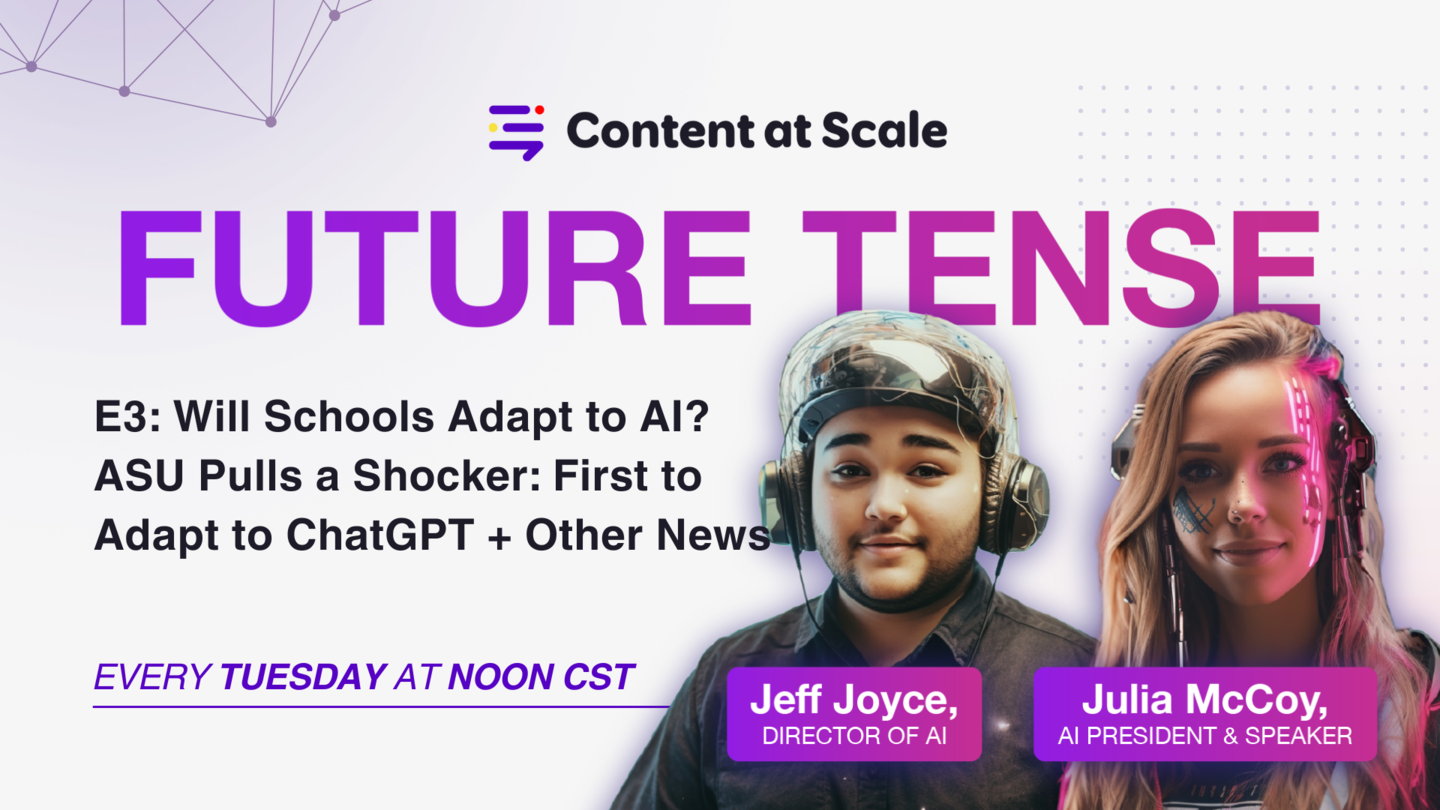Discover top guides, trends, tips and expertise from AIO Writers
Transforming Classrooms: The Impact of AI in Education Today
Julia McCoy
Thursday, 25th Jan 2024
Imagine the classroom of the future, brimming with artificial intelligence. It’s not a sci-fi fantasy; it’s happening right now. Education is getting a high-tech makeover, and AI systems like ChatGPT are leading the charge.
ChatGPT blew up faster than any tech before — 100 million signups in just weeks! Education leaders first slammed on the brakes, worried about cheating and lazy thinking. But soon enough, they saw its worth and hit the gas.
Should AI be allowed in schools?
In this week’s podcast episode, we discuss how Arizona State University trailblazed by weaving generative AI into writing classes. And as these smart bots get even smarter, we’re talking new rules for fair play in class and major players shaping learning itself.
This ride through AI in education will show you where we’ve been, what hurdles we’ve cleared, and what lies ahead— for students, teachers … everyone.
Listen to all episodes of our show, Future Tense. ✨ It’s the AI show worth listening to; because we’re doing the research, and all the work, to bring you AI news actually worth your time. We cut through the clutter and get to the game-changing info around AI. What you really need to know – like yesterday – to be informed. Listen now on the platform of your choice:
We stream every Tuesday: Sub to catch the stream.
The Rapid Rise and Integration of AI in Education
ChatGPT, like a comet streaking across the sky, has marked its place as the fastest technology to be adopted worldwide.
In less than two months since its release, it hit an astronomical 100 million signups, reshaping how we think about learning and teaching.
Schools from K-12 to universities are now onboarding artificial intelligence with open arms.
Gone are the days when students were confined to textbooks alone for knowledge.
Now they’re turning pages virtually with AI models like ChatGPT, which offers interactive learning experiences that cater to their individual needs at scale.
Initial Resistance and Subsequent Adoption of AI in Education
Skepticism initially greeted the entry of generative AI into classrooms. Educators were worried about students taking shortcuts and leaving critical thinking at the door.
School boards slapped bans on artificial intelligence tools like ChatGPT, trying to shield academic honesty like it was a fragile vase on the edge of a table. The thought was clear: keep pure learning safe from these smart machines.
The Journey from Ban to Apology
But as they say, change is the only constant. Educators began peeling back layers of this AI marvel and found more than just potential cheating scandals.
They saw an ally in personalized education — something that could shake up stale lesson plans and make one-on-one learning not just a dream but a reality for every student out there.
Policies made swift U-turns as teachers realized that with great power comes great responsibility — not just in superhero movies but also when wielding tools like ChatGPT in classrooms.
Embracing AI for Student Development
Educators are now rolling out the red carpet for AI. It’s becoming clearer that these tools can do wonders if used wisely — a boost rather than a bane to student development.
And those early bans?
Well, let’s call them growing pains on our way to smarter classrooms everywhere.
Real-World Applications of ChatGPT in Education
The buzz about AI in schools is loud, but what does it look like on the ground?
Let’s zero in on how ChatGPT shines in real classrooms.
Tailoring lessons to fit each student can be a Herculean task for teachers. Enter ChatGPT — it changes the game by customizing learning materials that meet students right where they are. Imagine an English class where every learner gets feedback that speaks directly to their writing style.
This isn’t just a neat trick; it hits at something deeper. When students feel seen and supported, they engage more deeply. That means better outcomes all around — a win-win for educators and learners alike.
We’re not talking hypotheticals here — these tools have already landed in some schools. They’re helping kids build skills faster than you can say “customized curriculum.” It shows us one thing: AI isn’t just changing education; it’s making it more human.
 Case Study: Arizona State University’s Pioneering AI Initiative
Case Study: Arizona State University’s Pioneering AI Initiative
Arizona State University (ASU) broke new ground by becoming the first educational institution to join forces with OpenAI.
Their aim? To craft personalized AI tutors for their writing classes, transforming how students learn and write.
These AI-powered assistants aren’t just fancy gadgets; they’re a testament to ASU’s commitment to innovation in student learning. By signing up for OpenAI’s enterprise plan, ASU took ChatGPT beyond casual chat use into an academic setting where it can offer tailored guidance and feedback — something that mirrors one-on-one tutoring sessions.
This move is more than just about staying ahead of the tech curve. It reflects a deep understanding that each student has unique needs when it comes to learning — a recognition that paves the way for other institutions looking at similar integration of cutting-edge tools like ChatGPT.
With this initiative, ASU isn’t merely adopting new technology; they are redefining educational boundaries and showing us what the future could look like.
This step towards individualized education might well be remembered as a defining moment in higher ed tech adoption, proving once again why ASU ranks among innovators pushing limits in academia today.
The Role of OpenAI and Meta in Shaping Educational Tools
When Mark Zuckerberg shared that Meta is working on open-source artificial general intelligence (AGI) to enhance the metaverse, it signaled a new era for educational tools.
This move by major tech players like OpenAI and Meta shows they’re serious about revolutionizing how we learn.
They are not just creating technology; they’re crafting experiences that could redefine education as we know it.
OpenAI’s language models have already begun transforming classroom dynamics, offering personalized learning at scale. Imagine an AI tutor fine-tuned to your learning style, ready 24/7 to help you master any subject — that’s where we’re heading.
In contrast, Meta’s vision for AGI stretches further into immersive learning within the metaverse. Their commitment hints at future classrooms without boundaries — a place where physical distance doesn’t limit access to world-class education or resources.
To stay ahead of this curve, educators must adapt quickly. They need strategies for incorporating these tools into their teaching methods while maintaining academic integrity and promoting equitable access among students.
Preparing Educators for an AI-Dominant Future
Educators today are on the cusp of a new era where artificial intelligence is no longer just a buzzword but an integral part of teaching and learning.
Professional Development Programs
Schools and districts have started rolling out professional development programs that do more than scratch the surface. These initiatives aim to transform teachers into AI-savvy educators who can confidently weave AI tools like ChatGPT into their lesson plans. Think about it as equipping educators with a Swiss Army knife for the digital age – they need to know which tool to use, when, and how.
Teachers are getting hands-on training to navigate these technologies because let’s face it, knowing how to leverage AI in classrooms could be as essential as classroom management skills were yesterday.
Curriculum Design Adjustments
The curriculum isn’t immune from this tech tidal wave either. Across the board, schools are infusing their curricula with courses that put AI literacy front and center — because students fluent in AI will likely be ahead of the curve in virtually any field they choose tomorrow.
This means math lessons might now include coding basics or English classes could involve using natural language processing tools for creative writing assignments.
By integrating these elements organically into existing subjects, we’re ensuring that our students don’t just learn about technology — they grow up alongside it.
The Ethical Implications of AI in Education
AI is a double-edged sword when it comes to education.
On one side, it opens doors to innovative learning experiences. On the other, it brings up serious ethical concerns that we can’t ignore.
Balancing Technology with Humanity
We’re at a crossroads where technology and humanity intersect more than ever before in classrooms.
Educators face the challenge of integrating AI without losing their irreplaceable human touch. It’s about finding harmony between tech-led efficiency and the warmth of personal interaction. This balance ensures that while students enjoy tailored educational tools from AI like ChatGPT, they also get valuable life skills only a teacher can impart.
Ensuring Equitable Access to AI Resources
The digital divide remains wide open for many students lacking access to these emerging technologies.
Acknowledging this gap is just step one; actively working towards closing it is what really counts.
Efforts are being made by institutions across the globe so every student gets an equal shot at benefiting from what AI has to offer — think free online resources or subsidized tech programs designed for low-income districts.
Equity here doesn’t just mean providing devices but ensuring everyone has reliable internet and ongoing support too because having tools isn’t enough if you don’t know how best to use them effectively in your learning journey.
Navigating Academic Honesty in an AI-Enhanced Learning Environment
Schools are stepping up their game by updating policies that govern the use of these smart assistants. They’re crafting rules that promote fair play while recognizing AI’s potential to support education.
We’ve seen ASU take the lead by integrating personalized AI tutors into writing classes. It shows us how boundaries can be pushed responsibly, ensuring students learn with integrity at heart.
The task ahead is clear: guidelines must evolve as fast as technology does so students can harness its full potential without crossing ethical lines. By doing this, educators will keep nurturing critical thinking skills essential for real-world success.
Will Schools Adapt to AI?
AI in education is changing the game. You’ve seen it with ChatGPT’s lightning-fast adoption, shifting from banned to embraced. Schools are updating policies; they’re on board now.
Think about ASU leading the way and setting up AI tutors for students. Remember that tech giants are stepping in too, shaping learning’s future.
Educators must gear up for an AI-rich teaching world. Training programs and curricula need revamps to keep pace with tech advances.
Weigh those ethical issues — privacy matters and equal access count big time.
But this isn’t just talk — it’s happening, right here, right now.
So cherish this moment and let AI in education unlock potential across classrooms everywhere.
Because when we embrace these tools wisely, everyone learns better — and isn’t that what it’s all about?

UNLOCK YOUR POTENTIAL
Long Headline that highlights Value Proposition of Lead Magnet
Grab a front row seat to our video masterclasses, interviews, case studies, tutorials, and guides.

 Case Study: Arizona State University’s Pioneering AI Initiative
Case Study: Arizona State University’s Pioneering AI Initiative
